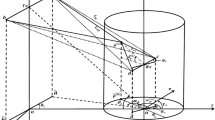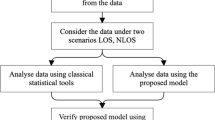Abstract
Millimeter waves (mmWs) are considered as one of the most promising technologies for future 5G networks. The current study presents a three-dimensional (3D) geometry-based channel model for a fixed-to-mobile non-isotropic Ricean mmW scattering environment. According to this 3D reference model, the mmW complex faded envelope impulse response has been derived. This impulse response has been employed in estimating the second-order statistics of the mmW channel model. These statistics comprise both the 3D faded envelope level crossing rate (LCR) and the average fade duration (AFD). As a consequence, these statistics may contribute to the 5G network planning and engineering, especially for studying the phenomenon of fading with time, the 5G system characteristics, the handoff scenarios, and the relationship between the mobile user velocity and the fading rate. Furthermore, this study also provides a stochastic sum-of-sinusoids mmW channel simulator for comparison with analytical results. Numerical results validated the proposed analytical model and revealed the effect of channel parameters on both LCR and AFD in the mmW bands.
Similar content being viewed by others
References
Rappaport, T.S.; et al.: Millimeter Wave Wireless Communications. Pearson/Prentice Hall, Upper Saddle River (2015)
Rappaport, T.S.; et al.: Millimeter wave mobile communications for 5G cellular: it will work!. IEEE Access 1(1), 335–349 (2013)
Azar, Y.; et al.: 28 GHz propagation measurements for outdoor cellular communications using steerable beam antennas in New York city. In: 2013 IEEE International Conference on Communications (ICC), Budapest, pp. 5143–5147 (2013)
MacCartney, G.R.; Rappaport, T.S.: 73 GHz millimeter wave propagation measurements for outdoor urban mobile and backhaul communications in New York City. In: IEEE International Conference on Communications (ICC), pp. 4862–4867 (2014)
MacCartney, G.R.; Samimi, M.K.; Rappaport, T.S.: Omnidirectional path loss models in New York City at 28 GHz and 73 GHz. In: 2014 IEEE 25th Annual International Symposium on Personal, Indoor, and Mobile Radio Communication (PIMRC), Washington DC, pp. 227–231 (2014)
Rappaport, T.S.; Murdock, J.N.; Gutierrez, F.: State of the art in 60-GHz integrated circuits and systems for wireless communications. Proc. IEEE 99(8), 1386–1389 (2011)
Samimi, M.K.; Rappaport, T.S.: Ultra-wideband statistical channel model for 28 GHz millimeter-wave urban NLOS environments. In: Proceedings of IEEE GlobeCom, pp. 3483–3489 (2014)
Samimi, M.K.; Rappaport, T.S.: 3-D millimeter-wave statistical channel model for 5G wireless system design. IEEE Trans. Microw. Theory Tech. 64(7), 2207–2225 (2016)
3GPP TR 36.873, v1.3.0 Study on 3D channel model for LTE (Release 12). February, 2014. (Available at www.3gpp.org)
Va, V.; Heath Jr., R.W.: Basic relationship between channel coherence time and beam width in vehicular channels. In: Proceedings of IEEE VTC fall, pp. 3483–3489 (2015)
Va V.; Choi, J.; Heath Jr., R.W.: Channel variation in vehicular channels and its implications. arXiv:1511.02937v1 [cs.IT], 9 (2015)
El-atty, S.M.A.; Gharsseldien, Z.M.: Performance analysis of an advanced heterogeneous mobile network architecture with multiple small cell layers. Wireless Netw. 23(4), 1169–1190 (2017)
Aulin, T.: A modified model for the fading at a mobile radio channel. IEEE Trans. Veh. Technol. 28(3), 182–203 (1979)
Turkmani, A.M.D.; Parsons, J.D.: Characterization of mobile radio signals: model description. IEE Proc. I 138(6), 557–565 (1991)
Leong, S.-Y.; Zheng, Y.R.; Xiao, C.: Space-time fading correlation functions of a 3-D MIMO channel model. Proc. IEEE WCNC Atlanta 2, 1127–1132 (2004)
Stüber, G.L.: Three-dimensional modeling, simulation, and capacity analysis of space-time correlated mobile-to-mobile channels. IEEE Trans. Veh. Technol. 57(4), 2042–2054 (2008)
Zajic, A.G.; Stüber, G.L.; Pratt, T.G.; Nguyen, S.: Envelope level crossing rate and average fade duration in mobile-to-mobile fading channels. In: Proceedings of IEEE ICC, pp. 4446–4450 (2008)
Eldowek, B.M.; et al.: Complex envelope second-order statistics in high-altitude platforms communication channels. Wirel. Pers. Commun. 77(4), 2517–2535 (2014)
Stuber, G.L.: Principle of Mobile Communication, 2nd edn. Kluwer, Boston (2001)
Patzold, M.: Mobile Radio Channels, 2nd edn. Wiley, New York (2012)
Rangan, S.; Rappaport, T.S.; Erkip, E.: Millimeter-wave cellular wireless networks: potentials and challenges. Proc. IEEE 102(3), 366–385 (2014)
Michailidis, E.T.; Kanatas, A.G.: Three-dimensional HAP-MIMO channels: modeling and analysis of space–time correlation. IEEE Trans. Veh. Technol. 59(5), 2232–2242 (2010)
Zajić, A.: Mobile-to-Mobile Wireless Channels. Artech House, Norwood (2013)
Pätzold, M.; Killat, U.; Laue, F.: An extended Suzuki model for land mobile satellite channels and its statistical properties. IEEE Trans. Veh. Technol. 47(2), 617–630 (1998)
Jakes, W.C.: Microwave Mobile Communications, 2nd edn. Wiley-IEEE Press, Piscataway (1994)
Abdi, A.; Barger, J.A.; Kaveh, M.: A parametric model for the distribution of the angle of arrival and the associated correlation function and power spectrum at the mobile station. IEEE Trans. Veh. Technol. 51(3), 425–434 (2002)
Yamada, Y.; Ebine, Y.; Nakajima, N.: Base station/vehicular antenna design techniques employed in high capacity land mobile communications system. Rev. Electr. Commun. Lab. NTT 35, 115–121 (1987)
Gradshteyn, I.S.; Ryzhik, I.M.: Special Functions, Chap. 8. In: Jeffrey, A., Zwillinger, D. (eds.) Table of Integrals, Series, and Product, 6th edn. Academic, San Diego (1994)
Mardia, K.V.; Jupp, P.E.: Directional Statistics. Wiley, New York (1999)
Samimi, M.K.; et al.: 28 GHz Millimeter-wave ultra-wideband small-scale fading models in wireless channels, pp. 1–6. In: Proceedings of IEEE VTC, Spring (2016)
Author information
Authors and Affiliations
Corresponding author
Rights and permissions
About this article
Cite this article
Eldowek, B.M., El-atty, S.M.A., El-Rabaie, ES.M. et al. Second-Order Statistics Channel Model for 5G Millimeter-Wave Mobile Communications. Arab J Sci Eng 43, 2833–2842 (2018). https://doi.org/10.1007/s13369-017-2889-0
Received:
Accepted:
Published:
Issue Date:
DOI: https://doi.org/10.1007/s13369-017-2889-0




